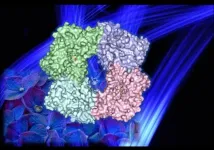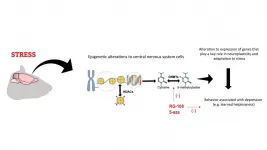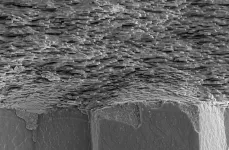Study resolves long-running controversy over critical step in gene silencing
The findings could yield important implications for development of drugs to treat cancer and other diseases.
2021-01-04
(Press-News.org) BOSTON - A long-running debate over how an important gene-silencing protein identifies its targets has been resolved by researchers at Massachusetts General Hospital (MGH). Their findings, reported in Nature Structural and Molecular Biology, also explain certain mysteries about the behavior of this protein, known as Polycomb repressive complex 2 (PRC2).
PRC2 helps regulate whether genes are active ("on) or silent ("off"). PRC2's role in gene silencing is critical throughout the lifespan, from embryo formation to old age. For example, PRC2 determines whether genes that suppress the growth of malignant tumors are turned on or off, which has made it the focus of pharmaceutical companies developing anti-cancer drugs.
But a mystery about PRC2 remained unsolved for years: How was the protein able to target specific genes? A major breakthrough occurred in 2008, when a team led by Jeannie Lee, MD, PhD, an investigator in the Department of Molecular Biology at MGH, proposed that RNA acts a recruiter for PRC2. RNA (or ribonucleic acid) is a molecule similar to DNA that's found in cells. RNA is usually a messenger that does DNA's bidding by spelling out the code to make proteins, but that is not the case here. Rather, Lee and her colleagues demonstrated that RNA acts as a "free agent" that binds to PRC2. RNA then targets PRC2 to a specific gene in order to silence it.
After Lee and her colleagues reported their discovery, dozens of other papers were subsequently published that supported the theory that RNA recruits PRC2 as a necessary step in gene silencing. However, studies from several prominent labs have challenged these findings, leading to an ongoing and often-heated debate about the relationship between PRC2 and RNA. These critics questioned Lee's discovery on two grounds:
PRC2 isn't specific and can bind with any RNA (some scientists noted that the protein is "promiscuous"), suggesting that RNA can't be a factor in targeting PRC2 for gene silencing.
The interaction between PRC2 and RNA often occur at genes that are active, an indication that this relationship isn't important for silencing specific genes.
The new study resolves both critiques. In the first case, explains Lee, think of PRC2 as a letter that needs to be delivered by a mail carrier, but lacks an address. How does the mail carrier know where to deliver it - that is, what is the "address" of the gene to be targeted for silencing? "The address is written on the RNA," says Lee. "RNA is an exact copy of DNA, where our genes are encoded." Lee and her colleagues identified "motifs," or unique sequences in RNA, which allow it to be recognized by PRC2. The RNA "address" then guides PRC2 to a specific gene location. This possibility had been proposed in the past, but Lee and her team now shed new light on how motifs make possible specific interactions between PRC2 and RNA that enable targeting.
Lee uses another analogy to explain why PRC2 and RNA often interact at genes that are not silenced. In the past, light bulbs could only be turned on or off, but the invention of the dimmer switch allowed for them to cast soft or bright light. Likewise, genes are not always turned completely on or off, and PRC2 acts like a dimmer switch. "We are saying that the genes are 'on,' but only yielding dim light," says Lee. "If you took away the Polycomb-RNA interaction, the genes would turn up and shine brightly."
By reconciling past disputes over how PCR2 interacts with RNA, says Lee, this new unified model advances basic science and provides invaluable insights for developers of new therapeutics.
INFORMATION:
Lee is senior author of the study. She heads the Lee Laboratory and is a professor of Genetics at Harvard Medical School. Postdoctoral fellow Michael Rosenberg, PhD, and research specialist Roy Blum, PhD, were the first authors of the study.
The work was funded by the National Institutes of Health and the Howard Hughes Medical Institute.
About the Massachusetts General Hospital
Massachusetts General Hospital, founded in 1811, is the original and largest teaching hospital of Harvard Medical School. The Mass General Research Institute conducts the largest hospital-based research program in the nation, with annual research operations of more than $1 billion and comprises more than 9,500 researchers working across more than 30 institutes, centers and departments. In August 2020, Mass General was named #6 in the U.S. News & World Report list of "America's Best Hospitals."
ELSE PRESS RELEASES FROM THIS DATE:
2021-01-04
If you've ever had a bad case of jet lag, you know how a disruption to your body's circadian rhythm makes it difficult to function. Molecular circadian "clocks" exist in cells throughout the body, governing more than just sleep and wake cycles - they are crucial to many aspects of human health. For more than a decade researchers have been trying to figure out what makes them tick, in search of new insights into diseases like Alzheimer's, cancer and diabetes.
Until now, that research has focused on what is known as clock genes, which encode proteins that drive oscillating cycles of gene expression affecting physiology and behavior. But research just published in the Proceedings of the National Academy of Sciences reveals the discovery ...
2021-01-04
Plants can perceive and react to light across a wide spectrum. New research from Prof. Nitzan Shabek's laboratory in the Department of Plant Biology, College of Biological Sciences shows how plants can respond to blue light in particular.
"Plants can see much better than we can," Shabek said.
Plants don't have dedicated light-detecting organs, like our eyes. They do have a variety of dedicated receptors that can sense almost every single wavelength. One such are the blue light photoreceptors called cryptochromes. When the cryptochrome detects an incoming photon, it reacts in a way that triggers a unique physiological response.
Cryptochromes probably appeared billions of years ago with the first living ...
2021-01-04
By Karina Ninni | Agência FAPESP – Treatment of depression faces two main challenges. The first is that almost 50% of patients do not respond well to existing antidepressants. The second is that conventional medications take a relatively long time – around three to five weeks – to have the desired effect. A group of researchers affiliated with the University of São Paulo (USP) in Brazil set out to tackle the second problem by using epigenetic modulators to try to “erase” the consequences of stress. Epigenetic mechanisms are part of a complex system that controls how and when genes are switched on or off.
Exposure to stress, a key trigger of depression, alters certain epigenetic markers in the brain. Many of these alterations ...
2021-01-04
The coronavirus pandemic is creating a large spike in significant psychological distress among Americans, with the first month of the pandemic causing as much distress in the same number of individuals that experienced it during the whole previous year, according to a new RAND Corporation study.
Findings from the first longitudinal study of psychological distress during the pandemic show that among a representative sample of Americans, more than 10% reported experiencing symptoms of significant psychological distress during April and May of 2020 -- the same amount they reported experiencing over an entire year during a survey conducted a year earlier.
The study also found that people with distress prior to the ...
2021-01-04
Scientists have long been aware of the dangerous overuse of antibiotics and the increasing number of antibiotic-resistant microbes that have resulted. While over-prescription of antibiotics for medicinal use has unsettling implications for human health, so too does the increasing presence of antibiotics in the natural environment. The latter may stem from the improper disposal of medicines, but also from the biotechnology field, which has depended on antibiotics as a selection device in the lab.
"In biotech, we have for a long time relied on antibiotic and chemical selections to kill cells that we don't want to grow," said UC Santa Barbara chemical engineer Michelle ...
2021-01-04
Following the repeal of the short-lived Cook County, Illinois Sweetened Beverage Tax, sales of sweetened beverages went right back to where they were before the tax went into place, according to a new study led by researchers at the University of Illinois Chicago. The study is published in JAMA Network Open.
The tax, which included both sugar-sweetened and artificially-sweetened diet beverages, was largely pitched as a way to reduce county budget deficits. The tax lasted just four months -- it went into effect on Aug. 2, 2017 and ended on Dec. 1, 2017.
"We ...
2021-01-04
Mollusks build shells to protect their soft tissues from predators. Nacre, also known as the mother of pearl, has an intricate, highly regular structure that makes it an incredibly strong material. Depending on the species, nacres can reach tens of centimeters in length. No matter the size, each nacre is built from materials deposited by a multitude of single cells at multiple different locations at the same time. How exactly this highly periodic and uniform structure emerges from the initial disorder was unknown until now.
Nacre formation starts uncoordinated ...
2021-01-04
Drones, robots and autonomous systems can transform the natural world in and around cities for people and wildlife.
International research, involving over 170 experts and led by the University of Leeds, assessed the opportunities and challenges that this cutting-edge technology could have for urban nature and green spaces.
The researchers highlighted opportunities to improve how we monitor nature, such as identifying emerging pests and ensuring plants are cared for, and helping people engage with and appreciate the natural world around them.
As robotics, autonomous vehicles and drones become more widely used across cities, pollution and traffic ...
2021-01-04
What The Study Did: In this observational study of 5,256 U.S. nursing home residents with COVID-19, increased age, male sex and impaired cognitive and physical function were independent risk factors for all-cause 30-day mortality.
Authors: Orestis A. Panagiotou, M.D., Ph.D., of the Brown University School of Public Health in Providence, Rhode Island, is the corresponding author.
To access the embargoed study: Visit our For The Media website at this link https://media.jamanetwork.com/
(doi:10.1001/jamainternmed.2020.7968)
Editor's Note: The article includes conflict of interest and funding/support disclosures. Please see the article for additional information, ...
2021-01-04
What The Study Did: The findings of a survey study using data from California suggests the COVID-19 pandemic was associated with increases in self-reported worry about violence for oneself and others, increased firearm acquisition and changes in firearm storage practices.
Authors: Nicole Kravitz-Wirtz, Ph.D., M.P.H., University of California Firearm Violence Research Center and Violence Prevention Research Program, Department of Emergency Medicine, University of California Davis School of Medicine in Sacramento, is the corresponding ...
LAST 30 PRESS RELEASES:
[Press-News.org] Study resolves long-running controversy over critical step in gene silencing
The findings could yield important implications for development of drugs to treat cancer and other diseases.



